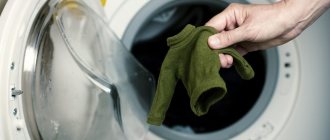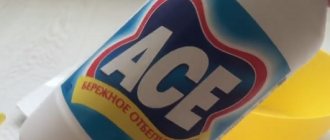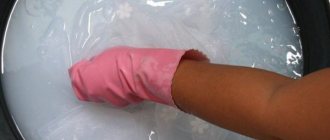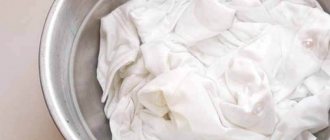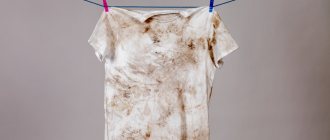Most fashionistas will definitely have at least one woolen item in their wardrobe. This material has earned popularity due to its attractive appearance and durability, but over time it tends to lose its original whiteness. So that you can extend the life of your favorite sweater, dress or cardigan, I propose to figure out together how to bleach woolen products at home.
Woolen items are highly durable, but tend to turn yellow over time.
Bleaching with household chemicals
The line of brands Vanish, Persol, Amway and Help contains products for bleaching wool products. Chemical bleaches are used according to the instructions on the package. Exceeding the treatment time with household chemicals leads to damage to wool fibers.
To wash woolen items with colored inserts, oxygen bleaches are used.
Shampoo for bleaching dog hair shows good results.
White
To prepare a solution, stir 50 ml of the product in 7-10 liters of warm water (30-40°C). The wool product is completely immersed in the solution and kept for 30-40 minutes, periodically turning over for uniform bleaching.
Chlorine is an aggressive component. The use of chlorine-containing bleaches is recommended in cases where other bleaching methods have not brought the desired result.
What does the industry offer?
We have already talked about one industrial bleach, “Whiteness”. But the modern range of household chemicals is so diverse that it allows you to choose other bleaching products.
When purchasing, make sure that the package is marked “For wool”, otherwise you may fail.
Note! For woolen items, neither powders nor bleaches with biological additives that destroy protein compounds should be used. The protein in the fabric will suffer in the same way as the stains, and the fabric will deteriorate.
Choosing the expensive “Vanish Oxy” or the classic “Swan” is a matter entirely dependent on your preferences and budget. Try it, experiment, share your feedback.
Machine washable
When bleaching woolen items during washing in an automatic machine, it is important to follow the following recommendations:
- use detergents for wool products;
- the amount of special bleach should not exceed the amount recommended in the instructions;
- washing temperature no more than 40°C;
- set the spin to the lowest speed;
- do not use machine drying.
Help: If you soak woolen items for 15 minutes in a soda solution (50 grams of soda per 5 liters of water) before washing, then you will not have to wash them additionally.
A little about soap
The laundry soap, beloved by housewives of the older generation, cannot be used to bleach woolen items at home. Soap contains a large number of different alkalis, and greatly damages the fabric.
It is also not used for washing wool; it is better to use special shampoos, and if they are not available, use your own hair shampoo. And remember that wool is contraindicated:
- high temperature and boiling;
- twisting and intensive machine spinning;
- drying on a line or hanger (things are laid out on a flat surface).
Follow our tips when bleaching at home, and your white wool items will cause slight envy of others.
How do you like the article?
Traditional methods
You can bleach white woolen items in more gentle ways that are effective and do not destroy the wool fibers. The ingredients needed for bleach solutions are inexpensive and found in every home.
Hydrogen peroxide
Mix peroxide in warm water in a ratio of 8:1. Calculate the volume of the solution so that the product is completely immersed in it. Leave the woolen jacket soaked in the mixture for 6-8 hours, then rinse thoroughly.
Soda (sodium bicarbonate)
Has good whitening characteristics. You can use both food grade and calcined. Baking soda added during machine washing will soften the water and improve the quality of the wash.
Dilute 100 grams of soda in 5 liters of cold water (up to 30°C) and place the woolen item for several hours. Soaking time depends on the degree of contamination. To increase the whitening effect, add 1 teaspoon of ammonia to the solution. When the bleaching result has reached the desired level, the item is removed and rinsed.
Important: The temperatures during bleaching and rinsing must be the same, otherwise the wool will fluff up.
Lemon acid
To get rid of yellowness on knitted items, soaking in a solution of citric or boric acid is suitable. The composition is prepared in the proportion of 1 tbsp. spoon of acid per 1 liter of water. The product is completely immersed and left until the desired result is obtained (usually 6-8 hours), after which it is thoroughly rinsed.
Help: When bleaching wool in any container, items must be turned over periodically to ensure uniform processing.
Chalk
For bleaching, prepare a solution at the rate of 1 kg of chalk per 400-500 grams of wool. The required amount is diluted in warm water in the proportion of 1 kg of chalk per 3 liters of water. Soak for 40-60 minutes, periodically stirring the composition to ensure even penetration into the fibers.
Rinse thoroughly, the last time with conditioner to make the product soft.
Ammonia
Whitens well and removes old stains.
- Soak clothes in the required amount of solution at the rate of 100 grams of ammonia per 10 liters of warm water for 30 minutes. Then, lightly wringing, wash in the machine with an additional rinse. If the smell of alcohol does not go away, rinse again with the addition of conditioner. Dry in the fresh air.
- In 2.5 liters of filtered water at a temperature of 40°C, dilute 50 ml of ammonia and 30 grams of salt. The container containing the woolen item is covered with cellophane and kept for 45 minutes. Then lightly hand wash and place in the washing machine to rinse with added conditioner.
- Dissolve 10 ml of ammonia in 6 liters of water and thoroughly rinse the sweater in the resulting composition. Squeeze lightly. Then for 30 minutes they are placed in a solution of 5 ml of hydrogen peroxide and 1 ml of ammonia per 1 liter of water. Rinse in a machine with air conditioning.
Salt
This whitening method is one of the most gentle. In addition, wool fibers treated with salt become softer.
Soak a woolen jacket in a saline solution (50 grams of salt per 10 liters of water) for 5-6 hours, after which it is rinsed well. If the whiteness of the product is not satisfactory, the procedure is repeated.
Hydrogen peroxide
This medical solution is a universal remedy that has good whitening properties. Hydrogen peroxide is safe, so it can be used to clean old stains from wool items. Knowing the properties of this product, you can whiten things in this way:
- Dilute 100 g of solution in 5 liters of water, the temperature of which should not exceed 30 °C.
- Immerse woolen clothing in a bowl with the resulting solution.
- Wait 5-7 hours.
- Lightly wring out the product, removing most of the moisture, and blot it with a dry towel.
- Dry the woolen item by placing it on a table or other flat surface. White woolen items should not be placed on magazines or newspapers, as the dye will easily be absorbed into the fibers of the material.
This is a simple and effective option for whitening white woolen items, since the items can be soaked overnight and simply rinsed and dried in the morning.
Wool threads
Gray or yellowed wool threads are bleached at high temperatures.
To do this you need:
- Laundry soap shavings are diluted in hot water;
- Boil the yarn in the solution until the desired result is achieved;
- rinse in warm water;
- During the last rinse, add vinegar to the water (1 tablespoon of vinegar per 2 liters of water).
The threads are also bleached with baby soap. To do this, place a skein of thread in a soap solution and boil for 20-30 minutes, turning it over periodically. If the solution turns dark, prepare a new one and repeat the procedure.
Specialized bleaches
Specialized bleaches for wool and silk (Perox, Vanish, etc.) are sold in hardware stores; their dosage and exposure time are indicated on the packaging. The effect of such products is based on the release of oxygen molecules, which remove contaminants from animal fibers without damage.
Yarn
To prevent the wool from matting, the yarn is processed at a temperature of 50°C. Bleaching is carried out in the following order:
- Skeins of yarn are tied with natural threads.
- Dilute a neutral detergent in the proportion of 1 gram per 1 liter of water. facilities.
- Thoroughly rinse the yarn in the solution and wring it out.
- Hydrogen peroxide (1/3 of the weight of the yarn), soda and office glue (1/10 of the weight of the yarn) are diluted in 10 liters of water.
- The yarn is placed in the resulting composition and kept for several hours, depending on the desired result.
- Rinse with vinegar.
Help: Natural fibers, except cotton, have a creamy or milky tint. Therefore, you can lighten a woolen item to a certain limit.
The yarn is also bleached with sodium hydrosulfite (1 tablespoon per 7 liters of water).
The powder is first diluted in a small amount of water and added to the bleaching container. The resulting solution is heated to a temperature of 40-50°C, the yarn is placed in it for 25-30 minutes and covered tightly with a lid. The cooled solution is heated to the desired temperature. The yarn is periodically turned over to ensure uniform processing. Rinse thoroughly until the smell disappears; add vinegar or conditioner during the last rinse.
Special means
The first thing that comes to the mind of modern housewives is to go to the store and choose something from a huge assortment. But here you need to know some details: after all, different formulas differ in the principle of action. There are three categories of bleaches.
- Chlorine - the well-known “Whiteness” and similar formulas (Ace Gel Ultra, “Zavkhoz”, DEXS). The bad thing is that due to the presence of chlorine in the composition, they damage the fiber, and with frequent use it becomes thinner and holes can form. They can only be used on dense natural fabrics; the rest will be irrevocably damaged. Chlorine also has a very pungent odor, is difficult to rinse out, and its toxic fumes are harmful to health. Among the advantages, it is worth noting high efficiency, antibacterial properties and low cost.
- Optical - they only create the illusion of purity. In fact, the canvas remained grayish in color. It’s just that reflective particles are now firmly fixed on top, which creates the appearance of white. One of the unpleasant features is poor rinsing. It is mainly used as an additive to washing powders and oxygen bleaches.
- Oxygen - Pure water, Synergetic, Sarma Active, Chirton Oxygen, Vanish and many others. Although they are expensive, these costs are justified. Such cleaners are gentle on the material: they do not thin it out and are suitable even for delicate products, work at low temperatures and almost do not cause allergies.
Bleach comes in different forms: soap, spray, pencil, powder, gel. The first three are intended more for spot treatment of some stains, while gel and powder formulas are used for hand and machine washing.
Read the label on how to use each formulation. After all, the formula of all products, even from the same group, is different, and it would be incorrect to give general recommendations here.
Drying
Bleached wool items must be dried. To ensure that the product does not deform and retain its shape, appearance and pleasant smell, the following rules must be observed:
- do not dry things on lines or hangers;
- place the woolen product on a horizontal surface covered with a terry towel;
- dry in a well-ventilated area or outside;
- When outdoors, do not expose things to direct sunlight.
With timely use of these methods, woolen items retain their original whiteness for a long time.
White woolen items: how to restore whiteness and get rid of grayness and yellowness
Even the highest quality woolen items lose their dazzling whiteness over time and acquire a yellowish or gray tint. Don't be upset, the situation can be improved.
But there is one subtlety - natural materials are often quite delicate. And you need to know exactly what products to use to bleach woolen items and return them to their original color, and not completely ruin them. There are many ways to do this using both household chemicals and folk recipes.
- Bleaches
- Folk remedies
- Pharmacy antiseptic - hydrogen peroxide
- Ammonia
- Salt
- Chalk
- Laundry soap or dishwashing detergent
- Acetylsalicylic acid, milk or soda
- Means for heavy soiling
Soda
If you don't have hydrogen peroxide on hand, you can use baking soda or soda ash. The solution is prepared in a similar way:
- dissolve baking soda in cool water;
- lower the sweater;
- We wait a couple of hours.
During this time, the wool will begin to bleach right before your eyes. We take out the item and rinse it in running water.
With this product you can provide ongoing care. To do this, add a little baking soda when washing. It softens water and neutralizes salts that negatively affect the condition of the coat.
Washing a knitted hat
How to wash a knitted hat so that it does not change in size? Everyone knows that such things can shrink or stretch if not handled correctly. To prevent this from happening, you should strictly adhere to the advice of experienced housewives:
- Washing is done by hand.
- For cleaning, use liquid detergents for delicate fabrics or hair shampoo.
- It is not recommended to soak products.
- To remove heavy stains or difficult-to-remove marks, you must first treat them with special products or household substances.
- Washing is carried out in water no higher than 30 degrees, so as not to shrink the item.
These recommendations will help preserve all the original characteristics of the headdress.
Washing is carried out in a container with water, where a small amount of the selected detergent is diluted. The product is placed in a basin and slightly squeezed, allowing water and product to pass through. The procedure is carried out for 3-5 minutes; rubbing and twisting the product is strictly prohibited. Rinse the washed hat in 4-5 waters until the liquid is completely transparent, at which point you can add a small amount of conditioner.
Dry the product by stuffing it with towels or putting it on a jar, while heating devices and direct sunlight should remain at a distance. Fresh air in partial shade with good ventilation would be ideal.
Choosing a product in the store
It's easy to get confused among the variety of options. Which remedy is better? Choose oxygen-containing bleach and you won’t go wrong. The only negative is the high price. But oxygen bleaches do not destroy fabric fibers. A white summer dress will definitely last a couple of seasons, even if you bleach it often.
This type of bleach has many advantages. They:
- effectively whitens, returning brightness to white, eliminating stains;
- suitable even for delicate materials, thanks to the chlorine-free composition;
- provide results even at low temperatures;
- designed specifically for washing machines;
- rarely cause allergies.
Oxygen bleaches can be used on colored clothing. With age and frequent washing, printed items lose their brightness. Oxygen will bring back colors and help get rid of the gray background.
As a result
As you can see, there are many ways to wash clothes, including quite budget-friendly home methods and innovative developments from the chemical industry. But I think it is always easier to avoid problems than to solve them. Therefore, in order not to have to fight for a long and painful time with yellowness and grayness, it is worth following some recommendations.
- Always wash whites separately from other shades.
- Do not store the item folded next to colored and black. This applies to the proximity on the shelves of the closet and in the basket for dirty laundry.
- It is better to dry white clothes in the sun: this preserves their brightness. But from drying, yellow stains appear on the heating radiator.
- Make sure the fabric is completely dry before storing it in the closet. Even a little under-dried, it will acquire a gray tint very quickly.
Share your whitening secrets in the comments and don’t forget to subscribe to updates!

